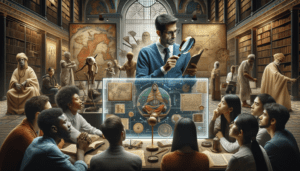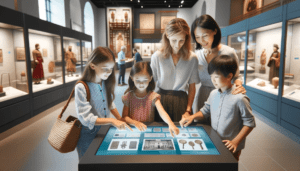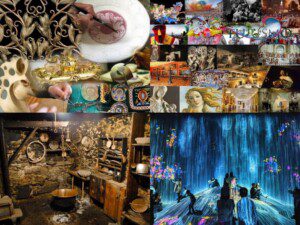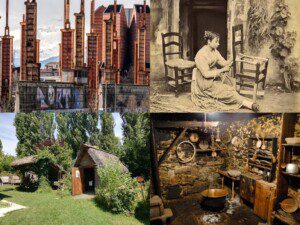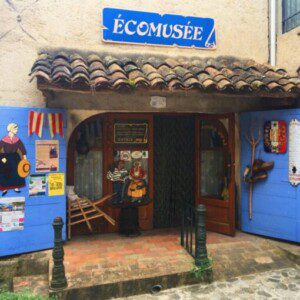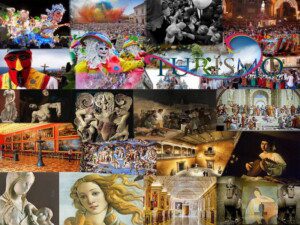The Principles of Cultural Heritage Interpretation
by Ignazio Caloggero
Reference Page: Special Heritage Interpretation (Heritage Interpretation)
Some definitions
Interpretation (Freeman Tilden – 1957)
“Educational activity that aspires to reveal meanings and relationships through the use of original objects, first-hand experiences and exemplifying means, rather than the mere transmission of facts”
Interpretation (Interpretation Canada – 1976)
“Interpretation is a communication process, designed to reveal the meanings and relationships of our cultural and natural heritage, through engagement with objects, artifacts, landscapes and sites”
Cultural Heritage Interpretation (Interpret Europe)
Heritage interpretation is the art of creating a relationship between the elements of a given site, or collection, on the one hand, and the visitors' personal framework of values and meanings on the other. In fact, interpretation: creates cognitive and emotional links between visitors and what they can discover in a natural area, historical site or museum; reveals deeper relationships and meanings, through direct experience and with the aid of means of illustration, rather than simply providing information. Interpretation also contains a structural educational component. (booklet Introduction to the Professional Development of Natural and Cultural Heritage Interpretation – InHerit Project)
Process of Interpretation (John A Veverka – 2011)
Any form of communication we may have with visitors usually involves two basic communication styles. We present the materials we want the visitor to know in an informative style, or in an interpretive style. The difference between the two styles is not what we present but how we present it. Informational styles simply dispense the facts, the way a field guide lists and describes species, for example. But the interpretive style reveals a larger story or message, relying on Tilden's Principles to help the visitor relate to that message.
Interpreting Experience Path (Ignazio Caloggero)
Cultural, educational, hermeneutical and systemic experiential path that aims to reveal the deepest meaning of things (Ignazio Caloggero 2022)
From a pedagogical point of view, the model that best suits the paths of Interpreting Experience is the constructivist one
constructivist approach: didactic planning models for meanings (or for research-action); At the center of the training process is the student, learning is seen as an interactive process between teacher and student and takes place through direct experiences (experiential learning)
When it comes to interpretation it is appropriate to distinguish between:
- Interpretation services (mediated interpretation): Realization of communication tools and services (signs, signs, maps, illustrative brochures, guides, flyers, multimedia productions and stations, installations, websites, apps, etc.) and design of Interpretation Plans
- Interpretation Experience Paths (direct interpretation): Initiatives that provide for the direct participation of both interpreters and guests in the interpretative activities.
Freeman Tilden's Principles of Interpretation]
- Any interpretation that does not relate what is illustrated or exhibited to an aspect of the visitor's personality or experience will be sterile.
- Information itself is not interpretation. Interpretation is revelation based on information. But they are two entirely different things, although all interpretation includes information. However, every interpretation activity contains information.
- Interpretation is an art that combines others, whatever the subject exposed: scientific, historical, architectural. And to some extent, any art can be taught.
- The main purpose of interpretation is not to educate but to provoke.
- Interpretation should aim to present the whole rather than a part and should address the man as a whole rather than just one stage of his development.
- The interpretation aimed at children (up to about 12 years of age) should not be a dilution of what is proposed to adults, but have a completely different approach. It will require specific and separate programs for the best
The Principles of Cultural Heritage Interpretation revisited by Ignazio Caloggero
In the Special “Towards an Economy of Experiences” I introduced the concept of experiential path and illustrated the ten principles of Experiences, given the intimate relationship between the concept of experience and that of interpretation, I propose here, a review of Tilden's principles by integrating them with those of experiential paths and adapting them with the very concept of “Interpretation”.
The Principles of Interpretation revisited by Ignazio Caloggero
- Multisensory Approach: The interpretation must be multisensory as much as possible (involvement of at least two or more senses: sight, hearing, touch, smell, taste)
- Cultural Approach (Local Identities): The interpretation must allow to deepen the knowledge of elements of local identity
- Uniqueness: the Interpreting experience path must have characteristics of uniqueness
- Centrality of the participants: Each interpretation must take into account the participants and take into account their centrality with respect to the context.
- Participation: the Interpretation experience path must foresee the participation, possibly direct, of the guest in the activities
- Educational Process (Experiential Learning): Interpretation must include an experiential learning phase, possibly through the direct participation of the guest in the activities.
- Thematic approach: each interpretation it will have to be built starting from a theme that characterizes it and that constitutes its guiding thread.
- aesthetic approach: the aesthetic approach is one of the elements, together with that of direct participation, at the basis of the concept of "immersion". The events that constitute "the staging of the experience" must be designed in such a way as to give importance to all the aspects that can influence the aesthetics: the atmosphere, the sense of beauty, the place chosen for the experience, the plot (screenplay) which must be consistent with the chosen theme and the identified place.
- Entertainment: Each Interpretation Experience path should also include moments of entertainment that enrich and make the experience enjoyable.
- Immersion: The principle of immersion, as well as in experiential paths, is the direct consequence of the application of the principles of multisensoriality, direct participation and aesthetic approach
- Revelation (hermeneutical communication): Interpretation is a hermeneutic communicative process (whether art or discipline), which aims to reveal the deepest meaning of things. Revelation occurs through the transformation of experience.
- Provocation (communication based on provocation): the communicative process that allows the interpreter to reveal (not teach) and the participant of the path of experience to discover (not to learn) takes place thanks to the provocation, on the part of the interpreter, of the participants' curiosity and involvement.
- Systemic approach (holistic view): The interpretation must take place with a holistic approach, it should take into account all the aspects, the relationships and links between the participants, the well (or phenomenon) interpreted and the context in which one finds the three elements at the base of the interpretation: the interpreter, the good (or phenomenon) and the participant.
- Tailored approach: The interpretation must take into account both the target of the final users: age, schooling, social context of belonging, and other variables such as expressed and implicit needs of the users themselves. For each target identified, the following must be identified: specific themes, methods and programmes.
- Creative approach: The interpretation process must precede a communicative style that must involve the whole dynamic of thought, describing places and facts in a creative and engaging way and using interpretative techniques such as storytelling and creative writing
- Interpretation based on facts: Interpretation must originally have concrete facts and places. The information on which the interpretation is based must be based on in-depth and quality data and information
- Simplicity and communicative coherence: Interpretation must include language that is not overly technical, lengthy or irrelevant to the context to be interpreted
- Emotional connection (passion): The interpreter must love the object of the interpretation, the result of the interpretation is strongly correlated to the passion and emotional connection that binds the interpreter and the phenomenon to be interpreted.
The first ten principles are nothing but the experiential principles.
In relation to the principles of interpretation it is possible to classify three levels of interpretation and consequently three levels of experiences of interpretation of Cultural Heritage:
- Simple interpretation (first level): application of principles 1, 2, 3, 11, 12, 13, 16
- authentic interpretation (second level): application of principles 1, 2, 3, 4, 5, 6, 7, 11, 12, 13, 16
- Full interpretation (third level): application of principles 1, 2, 3, 4, 5, 6, 7, 8, 9, 10, 11, 12, 13, 14, 15, 16, 17, 18
A definition of the three levels of interpretation that takes into account the applied principles could be the following:
- Simple interpretation (first level)
Interpretation of cultural heritage which aims, through a holistic approach, to reveal the deepest meaning of things through a unique, multi-sensory communication process based on provocation and the validity of facts.
- Authentic interpretation (second level)
Interpretation of cultural heritage that aims, through a holistic approach, to reveal the deepest meaning of things through a multi-sensory, unique, thematic communicative process, based on provocation, substantiation of facts, human relationships and direct participation of guests' participants in the activities that constitute the interpretive experience
- Full interpretation (third level)
Interpretation of cultural heritage that aims, through a creative, holistic, aesthetic, immersive and tailor-made approach, to reveal the deepest meaning of things through a multi-sensory, unique, thematic, coherent communication process, based on provocation, factual foundations, relationships human beings and direct participation of the guests' participants in the activities, including entertainment, which make up the interpretative experience.
In the following table we can see the correlation existing between the principles revisited by Ignazio Caloggero, the principles of the experiential paths proposed by the same author and Tilden's Principles.
| Principles of Interpretation paths | Principles of experiential paths | Tilden principles |
| 1 Multisensory Approach | 1 | |
| 2 Cultural approach (Local identities) | 2 | |
| 3 Uniqueness of the Experience | 3 | |
| 4 Relational approach (centrality and uniqueness of people) | 4 | 1 |
| 5 Direct participation | 5 | 1 |
| 6 Experiential learning (educational process) | 6 | |
| 7 Thematic approach | 7 | |
| 8 Aesthetic approach | 8 | |
| 9 Entertainment | 9 | |
| 10 Immersion | 10 | |
| 11 Revelation (hermeneutical communication) | 2,3 | |
| 12 Provocation | 4 | |
| 13 Systemic approach | 5 | |
| 14 Tailored approach | 6 | |
| 15 Creative approach | 3 | |
| 16 Interpretation based on facts | 2,3 | |
| 17 Simplicity and communicative coherence | ||
| 18 Emotional connection (passion) |
Tilden's Principle 3 actually falls within the hermeneutical approach. In fact, the fact that interpretation is an Art is a mere observation of fact linked to the very concept of hermeneutics.
Let's go deeper into the individual principles, remembering that the first ten principles are nothing more than the principles of the experiential path, this leads us to affirm that the Interpreter of Heritage is to all intents and purposes a Director of Experiences (Experiential Manager or Experience Manager).
An Interpretation Path is an experiential path (not the other way around) and is made up of a purely experiential component (principles 1 to 10) and a purely interpretative component (principles 11 to 18).
The purely interpretative components alone are not enough to create an interpretative path as the experiential components must also always be applied.
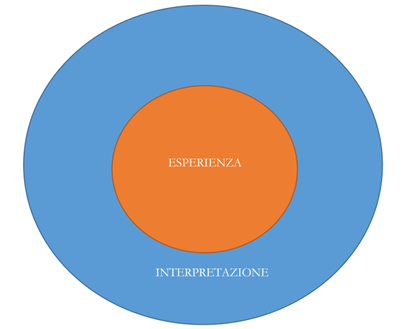
To learn more about the topics covered in this article:
Experiential Pathways and Cultural Heritage Interpretation Vol. 1: Origins and Theoretical Principles (free downloadable volume)
SPE100 Basic Course: Introduction to Experiential Pathways (25 hours online) (course usable within the project "Experiential Tourism and Interpretation of Cultural Heritage")
Basic Course SPE101: Principles of Interpretation of Cultural Heritage (Heritage Interpretation) (30 hours online) (course usable within the project "Experiential Tourism and Interpretation of Cultural Heritage")
Featured training
Basic courses
Thematic courses on the Design of Experiences
Courses with Professionalizing Certification pursuant to Law 4/2013





